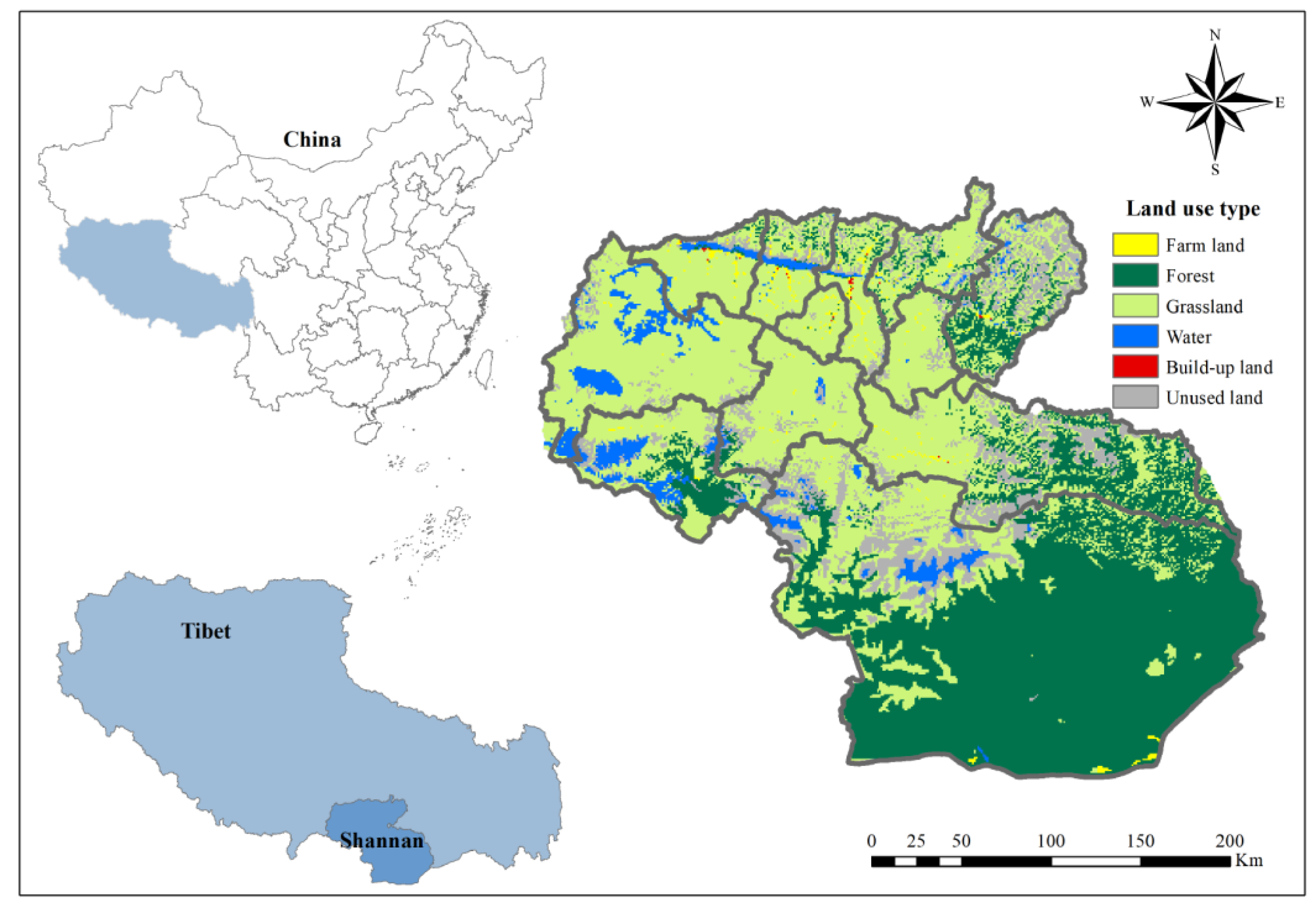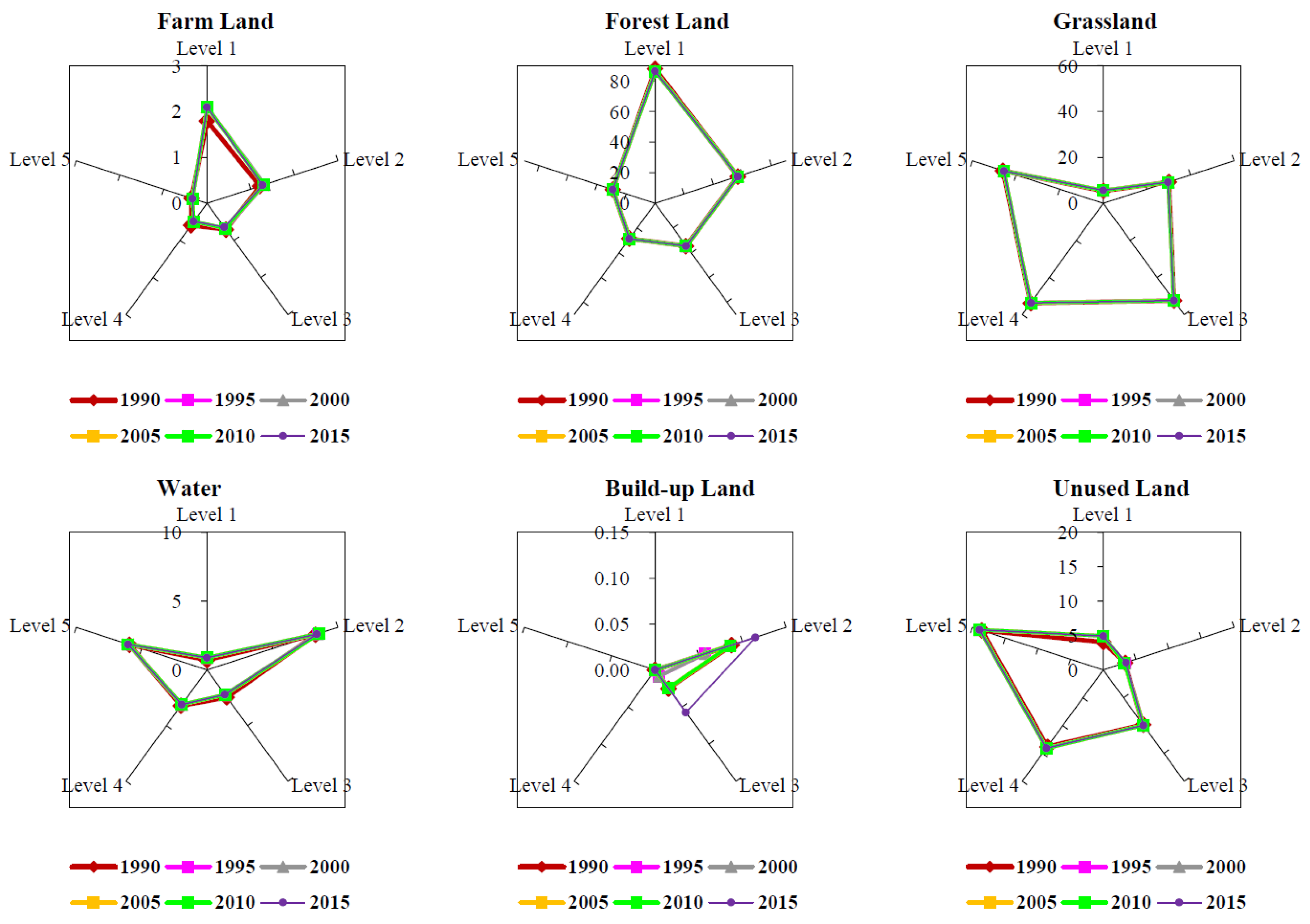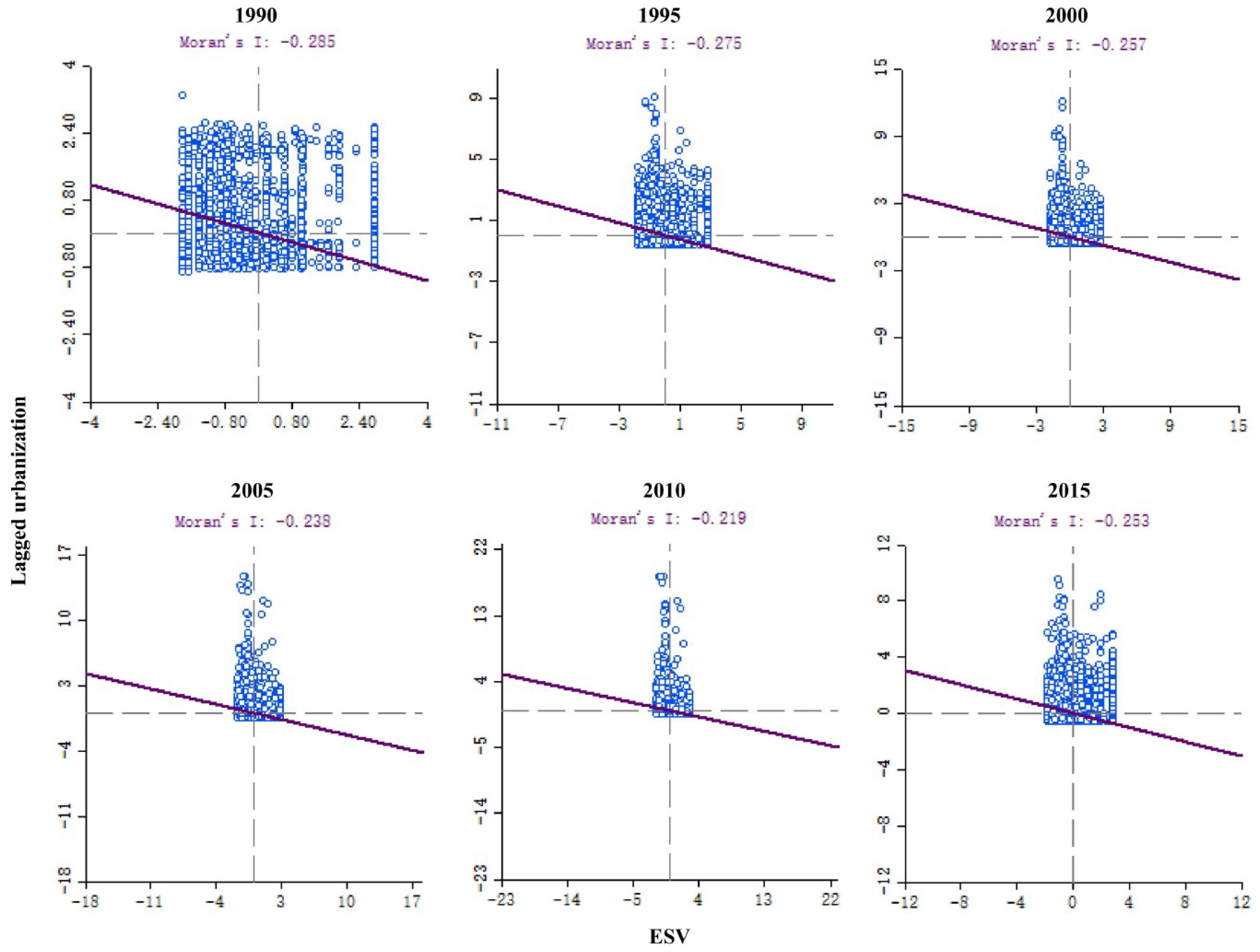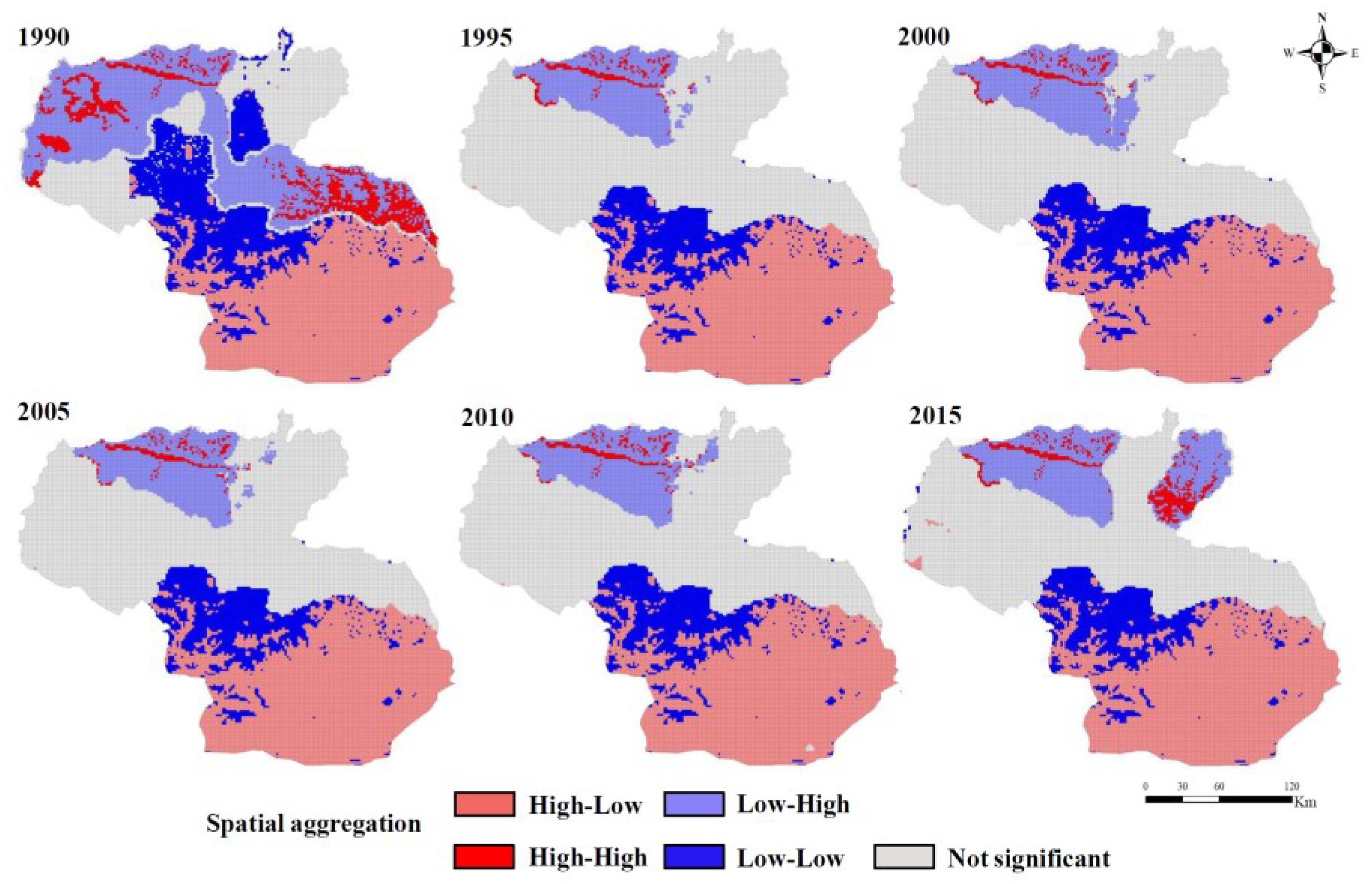Spatial Response of Ecosystem Service Value to Urbanization in Fragile Vegetation Areas Based on Terrain Gradient
Abstract
1. Introduction
2. Methodology
2.1. Study Area
2.2. Data Acquisition
2.3. Methods
2.3.1. Terrain Gradient Classification
2.3.2. Evaluation of Ecosystem Service
2.3.3. Urbanization Assessment
2.3.4. Spatial Correlation Exploration between ESV and Urbanization
3. Results
3.1. Spatial Pattern and Variation in Ecosystem Based on Terrain Gradient
3.2. Spatial Pattern and Variation in Ecosystem Service Value Based on Terrain Gradient
3.3. Spatial Correlation between ESV and Urbanization in Shannan
4. Discussion
4.1. Relationship between TG and ESV
4.2. Response of ESV to Urbanization
4.3. Limitations and Prospects
5. Conclusions
Author Contributions
Funding
Institutional Review Board Statement
Informed Consent Statement
Data Availability Statement
Conflicts of Interest
References
- Daily, G.C. Nature’s Services: Societal Dependence on Natural Ecosystems; Island Press: Washington, DC, USA, 1997. [Google Scholar]
- Costanza, R.; d’Arge, R.; de Groot, R.; Farber, S.; Grasso, M.; Hannon, B.; Limburg, K.; Naeem, S.; O’Neill, R.V.; Paruelo, J.; et al. The value of the world’s ecosystem services and natural capital. Nature 1997, 387, 253–260. [Google Scholar] [CrossRef]
- Ouyang, Z.Y.; Miao, H.; Wang, X.K. A primary study on Chinese terrestrial ecosystem services and their ecological-economic values. Acta Ecol. Sin. 1999, 19, 607–613. [Google Scholar]
- Li, T.H.; Li, W.K.; Qian, Z.H. Variations in ecosystem service value in response to land use changes in Shenzhen. Ecol. Econ. 2010, 69, 1427–1435. [Google Scholar]
- Wu, K.Y.; Ye, X.Y.; Qi, Z.F.; Zhang, H. Impacts of land use/land cover change and socioeconomic development on regional ecosystem services: The case of fast-growing Hangzhou metropolitan area, China. Cities 2013, 31, 276–284. [Google Scholar] [CrossRef]
- Niu, X.; Wang, B.; Liu, C.J.; Wei, W.; Kauppi, P.E. Economical assessment of forest ecosystem services in China: Characteristics and implications. Ecol. Complex. 2012, 11, 1–11. [Google Scholar] [CrossRef]
- Wan, L.L.; Ye, X.Y.; Lee, J.; Lu, X.; Zheng, L.; Wu, K. Effects of urbanization on ecosystem service values in a mineral resource-based city. Habitat Int. 2014, 46, 54–63. [Google Scholar] [CrossRef]
- Wang, J.H.; Tian, J.H.; Li, X.Y.; Ma, Y.; Yi, W. Evaluation of concordance between environment and economy in Qinghai Lake Watershed, Qinghai-Tibet Plateau. J. Geogr. Sci. 2011, 21, 949–960. [Google Scholar] [CrossRef]
- Ma, S.; Qiao, Y.P.; Wang, L.J.; Zhang, J.C. Terrain gradient variations in ecosystem services of different vegetation types in mountainous regions: Vegetation resource conservation and sustainable development. For. Ecol. Manag. 2021, 482, 118856. [Google Scholar] [CrossRef]
- Xu, C.X.; Gong, J.; Li, Y.; Yan, L.L.; Gao, B.L. The distribution characteristics of typical ecosystem services in Bailong River Basin of Gansu Province based on topographic gradient. J. Ecol. 2020, 40, 4291–4301. [Google Scholar]
- Chen, Y.Z.; Xiao, Y.; Sun, S.Q.; Guo, L. Spatial-temporal changes of ecosystem service values in Xiangxi region based on terrain. Chin. J. Eco-Agric. 2019, 27, 623–631. [Google Scholar] [CrossRef]
- Shi, Y.; Yuan, D.P.; Zhao, X.S.; Feng, Q.; Niu, Z.J.; Wang, S.T. Evaluation of ecosystem service values of mountainous basins in northwest Hebei Province based on terrain gradient—A case study of Huailai County, Hebei Province. Res. Soil Water Conserv. 2018, 25, 184–190. [Google Scholar]
- Wang, Y.; Dai, E.; Yin, L.; Ma, L. Land use/land cover change and the effects on ecosystem services in the Hengduan Mountain region, China. Ecosyst. Serv. 2018, 34, 55–67. [Google Scholar] [CrossRef]
- Li, L.; Zhu, W.B.; Li, Y.H. Ecosystem service value gains and losses of qihe river basin based on topographic gradient characteristics. Res. Soil Water Conserv. 2019, 26, 287–295. [Google Scholar] [CrossRef]
- Ehrlich, P.R.; Kareiva, P.M.; Daily, G.C. Securing natural capital and expanding equity to rescale civilization. Nature 2012, 486, 68–73. [Google Scholar] [CrossRef]
- Chen, Y.Y.; Ebenstein, A.; Greenstone, M.; Li, H. Evidence on the impact of sustained exposure to air pollution on life expectancy from China’s Huai River policy. Proc. Natl. Acad. Sci. USA 2013, 110, 12936–12941. [Google Scholar] [CrossRef]
- Liu, J.G.; Viña, A.; Yang, W.; Li, S.; Xu, W.; Zheng, H. China’s environment on a metacoupled planet. Annu. Rev. Environ. Resour. 2019, 43, 1–34. [Google Scholar] [CrossRef]
- Liu, B.; Pan, L.; Qi, Y.; Guan, X.; Li, J. Land Use and Land Cover Change in the Yellow River Basin from 1980 to 2015 and Its Impact on the Ecosystem Services. Land 2021, 10, 1080. [Google Scholar] [CrossRef]
- Lawler, J.J.; Lewis, D.J.; Nelson, E.; Plantinga, A.J.; Polasky, S.; Withey, J.C.; Helmers, D.P.; Martinuzzi, S.; Pennington, D.; Radeloff, V.C. Projected land-use change impacts on ecosystem services in the United States. Proc. Natl. Acad. Sci. USA 2014, 111, 7492–7497. [Google Scholar] [CrossRef]
- Bateman, I.; Harwood, A.R.; Mace, G.M.; Watson, R.T.; Abson, D.J.; Andrews, B.; Binner, A.; Crowe, A.; Day, B.H.; Termansen, M.; et al. Bringing ecosystem services into economic decision-making: Land use in the United Kingdom. Science 2013, 341, 45–50. [Google Scholar] [CrossRef]
- Zhang, Y.; Liu, Y.F.; Zang, Y.; Liu, Y.; Zhang, G.X.; Chen, Y.Y. On the spatial relationship between ecosystem services and urbanization: A case study in Wuhan, China. Sci. Total Environ. 2018, 637–638, 780–790. [Google Scholar] [CrossRef]
- Ouyang, X.; Zhu, X.; He, Q.Y. A study on the spatial interaction between urbanization and ecosystem services-Taking Changsha-Zhuzhou-Xiangtan urban agglomeration as an example. J. Ecol. 2019, 39, 7502–7513. [Google Scholar]
- Hu, C.X.; Guo, X.D.; Lian, G.; Zhang, Z.M. Effects of land use change on ecosystem service value in rapid urbanization area of Yangtze River Delta-Taking Jiaxing City as an example. Resour. Environ. Yangtze River Basin 2017, 26, 333–340. [Google Scholar]
- Zhu, C.L.; Zhang, J.F.; Zhao, Y.L.; Liu, C. Topographic gradient effects of typical watershed ecosystem services in the eastern Tibetan Plateau—A case study of the upper reaches of Minjiang River. Resour. Environ. Yangtze Basin 2017, 26, 1687–1699. [Google Scholar]
- Zou, Y.; Zhou, Z.X. Impact of landscape pattern change on ecosystem service value of Xi’an City, China. Chin. J. Appl. Ecol. 2017, 28, 2629–2639. [Google Scholar]
- Li, Q.; Li, T.; Yang, M.Z.; Ying, W. Spatiotemporal variation of ecosystem services value based on gradient analysis in Wuhan:2000–2010. Acta Ecol. Sin. 2017, 37, 2118–2125. [Google Scholar]
- Gao, H.J.; Han, H.Q.; Luo, X.Q.; Yu, H.Y.; Han, M.R. Spatial correlation of socioeconomic factors and ecosystem service values in Guizhou Province. Res. Soil Water Conserv. 2016, 23, 262–266. [Google Scholar]
- Fu, Q.; Li, B.; Hou, Y.; Bi, X.; Zhang, X. Effects of land use and climate change on ecosystem services in Central Asia’s arid regions: A case study in Altay Prefecture, China. Sci. Total Environ. 2017, 607, 633–646. [Google Scholar] [CrossRef]
- Yi, H.; Gueneralp, B.; Filippi, A.M.; Kreuter, U.P.; Güneralp, İ. Impacts of land change on ecosystem services in the San Antonio River Basin, Texas, from 1984 to 2010. Ecol. Econ. 2017, 135, 125–135. [Google Scholar]
- Jiang, X.Y.; Li, R.; Shi, Y.; Guo, L. Natural and Political Determinants of Ecological Vulnerability in the Qinghai–Tibet Plateau: A Case Study of Shannan, China. ISPRS Int. J. Geo-Inf. 2021, 10, 327. [Google Scholar] [CrossRef]
- Xiao, Y.; Xiong, Q.; Liang, P.; Xiao, Q. Potential risk to water resources under eco-restoration policy and global change in the Tibetan Platea. Environ. Res. Lett. 2021, 16, 094004. [Google Scholar] [CrossRef]
- Xu, N.Y.; Sun, S.Q.; Xue, D.Y.; Guo, L. Ecosystem service value and its spatial response to human interference on the basis of terrain gradient in Gannan region. Acta Ecol. Sin. 2019, 39, 97–107. [Google Scholar]
- Xian, C.; Zhang, X.; Zhang, J.; Fan, Y.; Zheng, H.; Salzman, J.; Ouyang, Z. Recent patterns of anthropogenic reactive nitrogen emissions with urbanization in China: Dynamics, major problems, and potential solutions. Sci. Total Environ. 2019, 656, 1071–1081. [Google Scholar] [PubMed]
- Ouyang, Z.; Song, C.S.; Zheng, H.; Polasky, S.; Xiao, Y.; Bateman, I.J.; Liu, J.; Ruckelshaus, M.; Shi, F.; Xiao, Y.; et al. Using Gross Ecosystem Product (GEP) to value nature in decision-making. Proc. Natl. Acad. Sci. USA 2020, 117, 14593–14601. [Google Scholar] [CrossRef] [PubMed]
- Tibet Autonomous Region Bureau of Statistics. Tibet Statistical Yearbook 1991; China Statistics Press: Beijing, China, 1991. [Google Scholar]
- Tibet Autonomous Region Bureau of Statistics. Tibet statistical Yearbook 1996; China Statistics Press: Beijing, China, 1996. [Google Scholar]
- Tibet Autonomous Region Bureau of Statistics. Tibet statistical Yearbook 2001; China Statistics Press: Beijing, China, 2001. [Google Scholar]
- Tibet Autonomous Region Bureau of Statistics. Tibet statistical Yearbook 2006; China Statistics Press: Beijing, China, 2006. [Google Scholar]
- Tibet Autonomous Region Bureau of Statistics. Tibet statistical Yearbook 2011; China Statistics Press: Beijing, China, 2011. [Google Scholar]
- Tibet Autonomous Region Bureau of Statistics. Tibet statistical Yearbook 2016; China Statistics Press: Beijing, China, 2016. [Google Scholar]
- Jenks, G.F. The data model concept in statistical mapping. Int. Year. Book. Cartogr. 1967, 7, 186–190. [Google Scholar]
- Mugagga, F.; Kakembo, V.; Buyinza, M. Land use changes on the slopes of Mount Elgon and the implications for the occurrence of landslides. Catena 2012, 90, 39–46. [Google Scholar] [CrossRef]
- Xie, G.D.; Zhen, L.; Lu, C.X.; Xiao, Y.; Chen, C. Expert knowledge based valuation method of ecosystem services in China. J. Nat. Res. 2008, 23, 911–919. [Google Scholar]
- Xie, G.D.; Zhang, C.X.; Zhang, L.M.; Chen, W.H.; Li, S.M. Improvement of the evaluation method for ecosystem service value based on per unit area. J. Nat. Resour. 2015, 30, 1243–1254. [Google Scholar]
- John, F. China’s Urban Transition; University of Minnesota Press: Minneapolis, MN, USA, 2005. [Google Scholar]
- Bai, X.; Shi, P.; Liu, Y. Society: Realizing China’s urban dream. Nature 2014, 509, 158–160. [Google Scholar] [CrossRef]
- Peng, J.; Tian, L.; Liu, Y. Ecosystem services response to urbanization in metropolitan areas: Thresholds identification. Sci. Total Environ. 2017, 607–608, 706–714. [Google Scholar] [CrossRef]
- Shi, Y.; Han, R.; Guo, L. Temporal-Spatial Distribution of Ecosystem Health and Its Response to Human Interference Based on Different Terrain Gradients: A Case Study in Gannan, China. Sustainability 2020, 12, 1773. [Google Scholar] [CrossRef]
- Anselin, L. Local indicators of spatial analysis—LISA. Geogr. Anal. 1995, 27, 93–115. [Google Scholar] [CrossRef]
- Amaral, P.V.; Anselin, L. Finite sample properties of Moran’s—Test for spatial autocorrelation in Tobit models. Pap. Reg. Sci. 2014, 93, 773–781. [Google Scholar] [CrossRef]
- Niu, Z.J.; Zhao, J.L.; Wang, X.Q.; Feng, Q.; Hao, L.N.; Ha, K.; Wang, S.T. Analysis of land use pattern change in hilly region of northwest Hebei province based on topographic gradient-taking Huailai county of Hebei province as an example. Stud. Soil Water Conserv. 2017, 24, 95–102. [Google Scholar]
- Xu, N.; Zhang, G.L.; Liu, Z.Y. Study on temporal and spatial variation of land use in Taihang Mountain area of Hebei Province based on topographic gradient. Chin. J. Ecol. Agric. 2013, 21, 1284–1292. [Google Scholar] [CrossRef]
- Zhao, Y.X.; Wu, A.B.; Liu, X.; Qin, Y.J. Land use gradient characteristics and ecological service value response in shallow hilly areas. Stud. Soil Water Conserv. 2014, 21, 141–145. [Google Scholar]
- Wang, X.F.; Xue, Y.Y.; Zhang, Y. Assessing the ecosystem service values in Shaanxi Province based on terrain. J. Glaciol. Geocryol. 2016, 38, 1432–1439. [Google Scholar]
- Ha, K.; Ding, Q.L.; Men, M.X.; Xu, H. Spatial distribution of land use and its relationship with terrain factors in hilly area. Geogr. Res. 2015, 34, 909–921. [Google Scholar]
- Wu, J.; Wang, S.S.; Tan, J. Analysis on terrain gradient effect based on land use change in Anhui Province. Resour. Environ. Yangtze Basin 2016, 25, 239–248. [Google Scholar]
- Bai, S.Y.; Wu, Q.; Shi, J.Q.; Lu, Y. Analysis on vegetation coverage change in Shannan, Tibet, China based on remotely sensed data. J. Desert Res. 2015, 35, 1396–1402. [Google Scholar]
- Zhou, H.B.; Wang, Z.T.; Wang, Z.J.; Bao, Y. Response of Ecosystem services value of Karst Mountainous City to Terrain Gradient—A case study of Downtown of Guiyang City. Res. Soil Water Conserv. 2021, 28, 337–347. [Google Scholar]
- Zhang, X.; Li, H.; Xia, H.; Tian, G.; Yin, Y.; Lei, Y.; Kim, G. The Ecosystem Services Value Change and Its Driving Forces Responding to Spatio-Temporal Process of Landscape Pattern in the Co-Urbanized Area. Land 2021, 10, 1043. [Google Scholar] [CrossRef]
- Cai, W.; Jiang, W.; Cai, Y. Developing an Ecosystem Services-Based Approach for Land Use Planning. Land 2021, 10, 419. [Google Scholar] [CrossRef]
- Xu, N.Y.; Guo, L.; Xue, D.Y.; Sun, S.Q. Land use structure and the dynamic evolution of ecosystem service value in Gannan region, China. Acta Ecol. Sin. 2019, 39, 1969–1978. [Google Scholar]
- Zhu, Z.Z.; Zhong, Y.X. Study on the temporal and spatial evolution of land use and ecosystem service value in Yangtze River Delta urban agglomeration. Resour. Environ. Yangtze River Basin 2019, 28, 1520–1530. [Google Scholar]
- Liu, R.F.; Zhang, J.M.; Xu, M.Q.; Li, J. Impacts of urbanization on ecosystem services and their temporal relations: A case study in Northern Ningxia, China. Land Use Policy 2018, 77, 163–173. [Google Scholar] [CrossRef]
- Zou, Z.Y.; Tong, W.; Xiao, Y.; Song, C.S.; Wang, K.L.; Ouyang, Z.Y. Valuing natural capital amidst rapid urbanization: Assessing the gross ecosystem product (GEP) of China’s “Chang-Zhu-Tan” megacity. Environ. Res. Lett. 2020, 15, 124019. [Google Scholar] [CrossRef]
- Su, S.L.; Li, D.L.; Hu, Y.N.; Xiao, R.; Zhang, Y. Spatially non-stationary response of ecosystem service value changes to urbanization in shanghai, China. Ecol. Indic. 2014, 45, 332–339. [Google Scholar] [CrossRef]
- Christopher, N.J.; Andrew, B.; Barry, W.B.; Jessie, C.B.; Mauro, G.; Lei, G.C.; Janet, M.W. Biodiversity losses and conservation responses in the Anthropocene. Science 2017, 356, 270–275. [Google Scholar]
- Mou, X.J.; Rao, S. Ecological environment changes and major ecological protection countermeasures in Qinghai-Tibet Plateau ecological barrier area during recent decade. Environ. Sci. Manag. 2015, 40, 160–164. [Google Scholar]
- Wang, Z.; Li, J.; Guo, Y.; Liang, L. Ecological protection and restoration model of multi-ecological elements in Qinghai-Tibet Plateau: A case study of Lhasa River Basin. Acta Ecol. Sin. 2019, 39, 8966–8974. [Google Scholar]
- Mandle, L.; Ouyang, Z.Y.; Salzman, J.; Gretchen, C. Green Growth That Works: Natural Capital Policy and Finance Mechanisms around the World; Island Press: Washington, DC, USA, 2019. [Google Scholar]
- Wu, J.H.; Wang, G.Z.; Chen, W.X.; Pan, S.P.; Zeng, J. Terrain gradient variations in the ecosystem services value of the Qinghai-Tibet Plateau, China. Glob. Ecol. Conserv. 2022, 34, e02008. [Google Scholar] [CrossRef]
- Huang, C.B.; Zhao, D.Y.; Deng, L. Landscape pattern simulation for ecosystem service value regulation of Three Gorges Reservoir Area, China. Environ. Impact Assess. Rev. 2022, 95, 106798. [Google Scholar] [CrossRef]
- NPC (The National People’s Congress of the People’s Republic of China). The State Council’s reports for the implementation of ‘China Western Development Strategy’ [EB/OL]. 2013. Available online: http://www.npc.gov.cn/npc/zxbg/gwygyssxbdkfzlqkdbg/2013-10/22/content1811909.htm (accessed on 13 May 2018).
- Chen, R.; Huang, C.B. Landscape Evolution and It’s Impact of Ecosystem Service Value of the Wuhan City, China. Int. J. Environ.-Ment. Res. Public Health 2021, 18, 13015. [Google Scholar] [CrossRef] [PubMed]






| TG | Farm Land | Forest Land | Grassland | Water | Build-Up Land | Unused Land |
|---|---|---|---|---|---|---|
| Level 1 | 20.0 | 0.9 | 7.6 | 28.6 | - | 25.3 |
| Level 2 | 7.2 | 1.9 | 0.5 | 3.0 | 33.3 | 6.1 |
| Level 3 | −7.1 | 2.5 | 1.9 | −8.1 | 133.3 | 3.1 |
| Level 4 | −15.5 | 2.4 | 1.8 | −1.0 | - | 4.0 |
| Level 5 | −4.3 | 2.0 | 1.2 | 3.9 | - | 3.9 |
| TG | 1990 | 1995 | 2000 | 2005 | 2010 | 2015 | Change |
|---|---|---|---|---|---|---|---|
| Level 1 | 1140.66 | 1139.97 | 1139.97 | 1139.97 | 1139.97 | 1139.97 | −0.70 |
| Level 2 | 3621.15 | 3616.99 | 3617.26 | 3620.84 | 3620.84 | 3604.98 | −16.17 |
| Level 3 | 4629.06 | 4629.10 | 4629.19 | 4629.02 | 4629.02 | 4626.35 | −2.72 |
| Level 4 | 4299.65 | 4301.09 | 4301.42 | 4301.38 | 4301.38 | 4300.53 | 0.88 |
| Level 5 | 2423.31 | 2423.00 | 2423.00 | 2423.00 | 2423.00 | 2423.19 | −0.12 |
Publisher’s Note: MDPI stays neutral with regard to jurisdictional claims in published maps and institutional affiliations. |
© 2022 by the authors. Licensee MDPI, Basel, Switzerland. This article is an open access article distributed under the terms and conditions of the Creative Commons Attribution (CC BY) license (https://creativecommons.org/licenses/by/4.0/).
Share and Cite
Zhang, J.; Liu, Z.; Shi, Y.; Zou, Z. Spatial Response of Ecosystem Service Value to Urbanization in Fragile Vegetation Areas Based on Terrain Gradient. Int. J. Environ. Res. Public Health 2022, 19, 15286. https://doi.org/10.3390/ijerph192215286
Zhang J, Liu Z, Shi Y, Zou Z. Spatial Response of Ecosystem Service Value to Urbanization in Fragile Vegetation Areas Based on Terrain Gradient. International Journal of Environmental Research and Public Health. 2022; 19(22):15286. https://doi.org/10.3390/ijerph192215286
Chicago/Turabian StyleZhang, Ji, Zelin Liu, Yu Shi, and Ziying Zou. 2022. "Spatial Response of Ecosystem Service Value to Urbanization in Fragile Vegetation Areas Based on Terrain Gradient" International Journal of Environmental Research and Public Health 19, no. 22: 15286. https://doi.org/10.3390/ijerph192215286
APA StyleZhang, J., Liu, Z., Shi, Y., & Zou, Z. (2022). Spatial Response of Ecosystem Service Value to Urbanization in Fragile Vegetation Areas Based on Terrain Gradient. International Journal of Environmental Research and Public Health, 19(22), 15286. https://doi.org/10.3390/ijerph192215286







